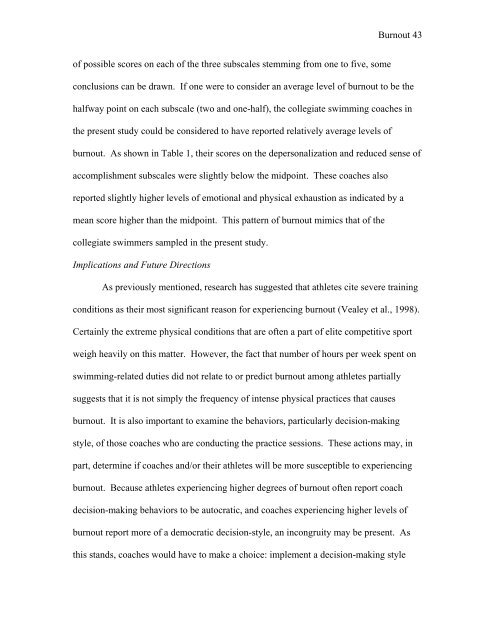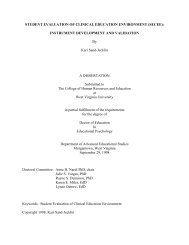Coach and Athlete Burnout - West Virginia University
Coach and Athlete Burnout - West Virginia University
Coach and Athlete Burnout - West Virginia University
You also want an ePaper? Increase the reach of your titles
YUMPU automatically turns print PDFs into web optimized ePapers that Google loves.
of possible scores on each of the three subscales stemming from one to five, some<br />
<strong>Burnout</strong> 43<br />
conclusions can be drawn. If one were to consider an average level of burnout to be the<br />
halfway point on each subscale (two <strong>and</strong> one-half), the collegiate swimming coaches in<br />
the present study could be considered to have reported relatively average levels of<br />
burnout. As shown in Table 1, their scores on the depersonalization <strong>and</strong> reduced sense of<br />
accomplishment subscales were slightly below the midpoint. These coaches also<br />
reported slightly higher levels of emotional <strong>and</strong> physical exhaustion as indicated by a<br />
mean score higher than the midpoint. This pattern of burnout mimics that of the<br />
collegiate swimmers sampled in the present study.<br />
Implications <strong>and</strong> Future Directions<br />
As previously mentioned, research has suggested that athletes cite severe training<br />
conditions as their most significant reason for experiencing burnout (Vealey et al., 1998).<br />
Certainly the extreme physical conditions that are often a part of elite competitive sport<br />
weigh heavily on this matter. However, the fact that number of hours per week spent on<br />
swimming-related duties did not relate to or predict burnout among athletes partially<br />
suggests that it is not simply the frequency of intense physical practices that causes<br />
burnout. It is also important to examine the behaviors, particularly decision-making<br />
style, of those coaches who are conducting the practice sessions. These actions may, in<br />
part, determine if coaches <strong>and</strong>/or their athletes will be more susceptible to experiencing<br />
burnout. Because athletes experiencing higher degrees of burnout often report coach<br />
decision-making behaviors to be autocratic, <strong>and</strong> coaches experiencing higher levels of<br />
burnout report more of a democratic decision-style, an incongruity may be present. As<br />
this st<strong>and</strong>s, coaches would have to make a choice: implement a decision-making style












